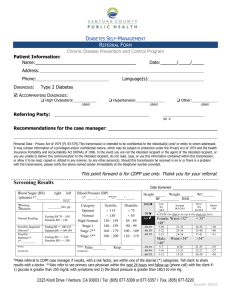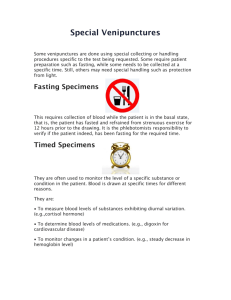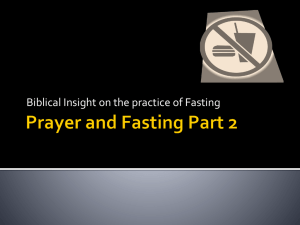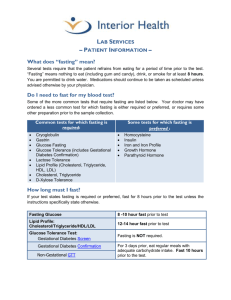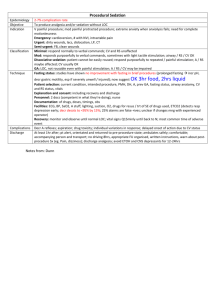The Protein-Retaining Effects of Growth Hormone During
advertisement
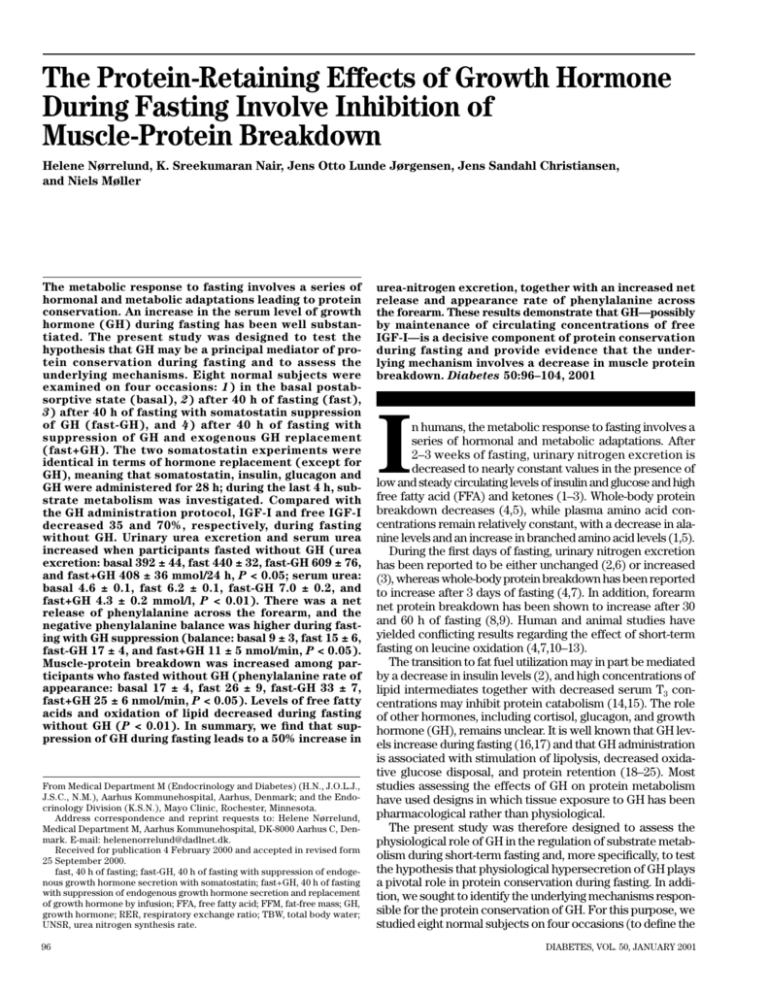
The Protein-Retaining Effects of Growth Hormone During Fasting Involve Inhibition of Muscle-Protein Breakdown Helene Nørrelund, K. Sreekumaran Nair, Jens Otto Lunde Jørgensen, Jens Sandahl Christiansen, and Niels Møller The metabolic response to fasting involves a series of hormonal and metabolic adaptations leading to protein conservation. An increase in the serum level of growth hormone (GH) during fasting has been well substantiated. The present study was designed to test the hypothesis that GH may be a principal mediator of protein conservation during fasting and to assess the underlying mechanisms. Eight normal subjects were examined on four occasions: 1) in the basal postabsorptive state (basal), 2) after 40 h of fasting (fast), 3) after 40 h of fasting with somatostatin suppression of GH (fast-GH), and 4) after 40 h of fasting with suppression of GH and exogenous GH replacement (fast+GH). The two somatostatin experiments were identical in terms of hormone replacement (except for GH), meaning that somatostatin, insulin, glucagon and GH were administered for 28 h; during the last 4 h, substrate metabolism was investigated. Compared with the GH administration protocol, IGF-I and free IGF-I decreased 35 and 70%, respectively, during fasting without GH. Urinary urea excretion and serum urea increased when participants fasted without GH (urea excretion: basal 392 ± 44, fast 440 ± 32, fast-GH 609 ± 76, and fast+GH 408 ± 36 mmol/24 h, P < 0.05; serum urea: basal 4.6 ± 0.1, fast 6.2 ± 0.1, fast-GH 7.0 ± 0.2, and fast+GH 4.3 ± 0.2 mmol/l, P < 0.01). There was a net release of phenylalanine across the forearm, and the negative phenylalanine balance was higher during fasting with GH suppression (balance: basal 9 ± 3, fast 15 ± 6, fast-GH 17 ± 4, and fast+GH 11 ± 5 nmol/min, P < 0.05). Muscle-protein breakdown was increased among participants who fasted without GH (phenylalanine rate of appearance: basal 17 ± 4, fast 26 ± 9, fast-GH 33 ± 7, fast+GH 25 ± 6 nmol/min, P < 0.05). Levels of free fatty acids and oxidation of lipid decreased during fasting without GH (P < 0.01). In summary, we find that suppression of GH during fasting leads to a 50% increase in From Medical Department M (Endocrinology and Diabetes) (H.N., J.O.L.J., J.S.C., N.M.), Aarhus Kommunehospital, Aarhus, Denmark; and the Endocrinology Division (K.S.N.), Mayo Clinic, Rochester, Minnesota. Address correspondence and reprint requests to: Helene Nørrelund, Medical Department M, Aarhus Kommunehospital, DK-8000 Aarhus C, Denmark. E-mail: helenenorrelund@dadlnet.dk. Received for publication 4 February 2000 and accepted in revised form 25 September 2000. fast, 40 h of fasting; fast-GH, 40 h of fasting with suppression of endogenous growth hormone secretion with somatostatin; fast+GH, 40 h of fasting with suppression of endogenous growth hormone secretion and replacement of growth hormone by infusion; FFA, free fatty acid; FFM, fat-free mass; GH, growth hormone; RER, respiratory exchange ratio; TBW, total body water; UNSR, urea nitrogen synthesis rate. 96 urea-nitrogen excretion, together with an increased net release and appearance rate of phenylalanine across the forearm. These results demonstrate that GH—possibly by maintenance of circulating concentrations of free IGF-I—is a decisive component of protein conservation during fasting and provide evidence that the underlying mechanism involves a decrease in muscle protein breakdown. Diabetes 50:96–104, 2001 I n humans, the metabolic response to fasting involves a series of hormonal and metabolic adaptations. After 2–3 weeks of fasting, urinary nitrogen excretion is decreased to nearly constant values in the presence of low and steady circulating levels of insulin and glucose and high free fatty acid (FFA) and ketones (1–3). Whole-body protein breakdown decreases (4,5), while plasma amino acid concentrations remain relatively constant, with a decrease in alanine levels and an increase in branched amino acid levels (1,5). During the first days of fasting, urinary nitrogen excretion has been reported to be either unchanged (2,6) or increased (3), whereas whole-body protein breakdown has been reported to increase after 3 days of fasting (4,7). In addition, forearm net protein breakdown has been shown to increase after 30 and 60 h of fasting (8,9). Human and animal studies have yielded conflicting results regarding the effect of short-term fasting on leucine oxidation (4,7,10–13). The transition to fat fuel utilization may in part be mediated by a decrease in insulin levels (2), and high concentrations of lipid intermediates together with decreased serum T3 concentrations may inhibit protein catabolism (14,15). The role of other hormones, including cortisol, glucagon, and growth hormone (GH), remains unclear. It is well known that GH levels increase during fasting (16,17) and that GH administration is associated with stimulation of lipolysis, decreased oxidative glucose disposal, and protein retention (18–25). Most studies assessing the effects of GH on protein metabolism have used designs in which tissue exposure to GH has been pharmacological rather than physiological. The present study was therefore designed to assess the physiological role of GH in the regulation of substrate metabolism during short-term fasting and, more specifically, to test the hypothesis that physiological hypersecretion of GH plays a pivotal role in protein conservation during fasting. In addition, we sought to identify the underlying mechanisms responsible for the protein conservation of GH. For this purpose, we studied eight normal subjects on four occasions (to define the DIABETES, VOL. 50, JANUARY 2001 H. NØRRELUND AND ASSOCIATES specific effects of GH) with concomitant determination of substrate oxidation, urea excretion, and whole body and regional muscle fluxes of phenylalanine and tyrosine. RESEARCH DESIGN AND METHODS The study population comprised eight healthy males (mean ± SE age 23 ± 0.4 years, BMI 23 ± 0.8 kg/m2), who were examined on four occasions. Before the study, subjects were on a weight-maintaining diet for at least 3 months. All subjects gave their written informed consent, and the study was approved by the regional ethics committee and conducted according to the Declaration of Helsinki. All subjects were instructed to maintain (for at least 3 days) their normal diet before admission; the participants were allocated to 1) basal postabsorptive investigations (basal), 2) 40 h of fasting (fast), 3) 40 h of fasting with suppression of endogenous GH secretion with somatostatin (fast-GH), or 4) 40 h of fasting with suppression of endogenous GH secretion and replacement of GH by infusion (fast+GH). During fasting with GH suppression, somatostatin, insulin, and glucagon were infused for the last 28 h. During fasting with GH replacement, GH was added to the protocol for the last 28 h. Somatostatin (200 µg/h) was infused together with insulin (Actrapid 100 I.E./ml, Novo Nordisk; infusion rate adjusted to maintain plasma glucose level between 3 and 5 mmol/l [0.15 and 0 mU · kg–1 · min–1]) and glucagon (GlucaGen 1 mg/ml, Novo Nordisk; the infusion rate adjusted to maintain stable glucose levels [1.0–1.5 ng · kg–1 · min–1]). The two somatostatin experiments were identical in terms of hormone replacement doses, except for GH (Norditropin 12 U/ml, Novo Nordisk; 4.5 U partly as bolus injections [0.375 U every fourth hour for 28 h], partly as continuous infusion [0.08 U/h]). To avoid hypoglycemia during fasting without GH, six participants temporarily received glucose intravenously (between 0.3 and 0.5 mg · kg–1 · min–1 for a period of 0.5–2.5 h); exactly the same amount of glucose was given in exactly the same manner in the experiment with GH replacement. Because potential hypoglycemia was anticipated during GH suppression, the fast-GH experiments were always conducted before fast+GH to allow for control of exogenous glucose. The subjects were blinded to this procedure. Otherwise, the sequence of experiments was random, with at least 6 weeks elapsing between each experiment. Somatostatin, insulin, glucagon, and GH infusions were continued for a total of 28 h. During the last 4 h, substrate metabolism was investigated. No participants received glucose during these last 4 h; glucose infusion was tapered at least 2 h before investigations of substrate metabolism were started. Blood was sampled frequently during the fast, and data are based on triplicate measurements within the last 30 min of the study. Urine for determination of urea was collected over a 16-h period in the postabsorptive state. In the three 40-h experiments, urine was collected from 0–24 h and while substrate metabolism was investigated (24–28 h). During fasting, only tap water was allowed. Measurements. All studies were performed with the participants in the supine position. Catheters for measurements of forearm arteriovenous substrate balances were placed as previously described (26). In brief, one catheter was placed retrogradely in a deep antecubital vein, and one catheter was inserted retrogradely in a heated contralateral dorsal hand vein. Criteria for correct positioning were oxygen saturations <70% and >91%, respectively. A third catheter was placed antegradely in an antecubital vein of the heated hand for infusions. Before each deep venous sample, total ipsilateral forearm blood flow was determined by means of venous occlusion plethysmography (27). Hand blood flow was interrupted by a wrist cuff inflated to a pressure of 250 mmHg immediately before each blood flow determination and 1 min before each deep venous sample. At 8:00 A.M., priming doses of [3-3H]glucose (New England Nuclear, Boston, MA) (20 µCi), L-[15N]phenylalanine (0.7 mg/kg), L-[2H4]tyrosine (0.5 mg/kg), and 15 L-[ N]tyrosine (0.3 mg/kg) (Cambridge Isotope Laboratories) were given to accomplish an early plateau. A continuous infusion of [3-3H]glucose (20 µCi/h), 15 –1 –1 2 –1 –1 L-[ N]phenylalanine (0.7 mg · kg · h ), and L-[ H4]tyrosine (0.5 mg · kg · h ) was started and maintained for 4 h. The chemical, isotopic, and optical purity of the isotopes was tested before use. Solutions were prepared under sterile conditions and were shown to be free of bacteria and pyrogen before use. The specific activity of tritiated glucose was assayed as previously described (19). 15 2 15 L-[ N]phenylalanine, L-[ H4]tyrosine, and L-[ N]tyrosine were measured as their t-butyldimethylsilyl ether derivatives under electron ionization conditions (28). Plasma concentrations of amino acids were determined by high-performance liquid chromatography (HP 1090 series 2 HPLC, 1046 fluorescence detector and cooling system) with precolumn O-phthalaldehyde derivatization (29). In addition, concentrations of phenylalanine and tyrosine were measured by mass spectrometry using -methylphenylalanine and -methyltyrosine, respectively, as internal standards (28). Fat-free mass (FFM), comprising both muscle tissue and nonmuscle fat-free tissue, was estimated by means of dual-energy X-ray absorptiometry scanning (Hologic QDR-1000/W, Waltham, DIABETES, VOL. 50, JANUARY 2001 MA). Plasma glucose levels were measured in duplicate immediately after sampling on a glucose analyzer (Beckman Instruments, Palo Alto, CA). A double monoclonal immunofluorometric assay (Delfia, Wallac, Finland) was used to measure serum GH. Plasma glucagon levels (30) and serum C-peptide (Immunoclear, Stillwater, MN) were measured by radioimmunoassay. Total and free IGF-I were determined as previously described (31,32). Insulin was determined by a commercial enzyme-linked immunosorbent assay (Dako, Glostrup, Denmark). Catecholamines were measured by liquid chromatography (33). Urea excretion was determined by an indophenol method and serum urea by a commercial kit (Cobas Integra, Roche, Hvidovre, Denmark). Cortisol was measured by an automated chemiluminescence system (Chiron Diagnostics, Fernwald, Germany). FFAs were determined by a colorimetric method using a commercial kit (Wako Chemicals, Neuss, Germany). Total and free hormone concentrations of T4 and T3 were measured in serum, as previously described (34). Thyrotrophin was measured in a solid-phase, two-site chemiluminescent enzyme immunometric assay (Immulite, DPC, Los Angeles). Indirect calorimetry (Deltatrac monitor, Datex Instrumentarium, Helsinki, Finland) was performed for 30 min (10:30 to 11:00 A.M.), allowing measurements of respiratory exchange ratios (RERs). The initial 5 min of calorimetry was used for acclimatization, and calculations were based on mean values of 25 measurements of 1 min each. Likewise, estimated rates of lipid and glucose oxidation and total energy expenditure were obtained by indirect calorimetry after correction for protein oxidation, as estimated by urinary excretion of urea (35). Net nonoxidative glucose disposal was calculated by subtracting glucose oxidation from the isotopically assayed total glucose disposal. Urea accumulation was determined assuming immediate dispersion of urea from the blood to total body water (TBW), which was estimated by the formula (36): TBW = (0.3625 BW) + (0.2239 BH) – (0.1387 Y) – 14.47 where Y is age (years), BW is body weight (kg), and BH is body height (cm). Urea nitrogen synthesis rate (UNSR) was determined as urinary excretion of urea corrected for accumulation of urea in total body water and for hydrolysis in gut (37). UNSR was calculated as urinary excretion rate (E), corrected for accumulation (A) in TBW and for the fractional intestinal loss (L): UNSR = (E + A)/(1 – L) where E = (urine flow, l/h) (urinary urea nitrogen, mmol/l) and A = (change in blood urea nitrogen, mmol · l–1 · h–1) (TBW) (l). L (fractional intestinal loss) was estimated to be 0.14. Phenylalanine kinetics. For measurements of whole body phenylalanine kinetics, the equations of Thompson et al. (38) were used. For regional phenylalanine kinetics, our previously described equations (28) were used. Phenylalanine flux (Qp) and tyrosine flux (Qt) were calculated as follows: Qflux = i[(Ei/Ep) – 1] in which i is the rate of tracer infusion (mmol · kg–1 · h–1), and Ei and Ep are enrichment of the tracer infused and plasma enrichment of the tracer at isotopic plateau, respectively. The rate of phenylalanine conversion to tyrosine (Ipt) was calculated as follows: Ipt = Qt ([15N]Tyrei / [15N]Pheei) (Qp / (Ip+Qp)) where [15N]Tyrei and [15N]Pheei are the isotopic enrichments of the respective tracers in plasma and Ip is the infusion rate of [15N]phenylalanine (mmol · kg–1 · h–1). Phenylalanine incorporation into protein was calculated by subtracting Ipt from Qp, because phenylalanine is irreversibly lost either by conversion into tyrosine or by incorporation into protein. In the forearm study, phenylalanine balance (PheBal) was calculated as follows: PheBal = (PheA – PheV) F in which PheA and PheV are phenylalanine concentrations in arteries and veins and F is blood flow. Regional protein breakdown represented by phenylalanine rate of appearance (Ra Phe) was calculated as follows (22): Ra Phe = PheA [(PheEA/PheEV) – 1] F in which PheEA and PheEV represent phenylalanine isotopic enrichment in arteries and veins, respectively. Local rate of disappearance was calculated as: Rd Phe = Phe Bal + Ra Phe. Statistics. Results are expressed as means ± SE. The Kolmogorov-Smirnov test was used to test for normal distribution. Statistical comparisons between the study periods (basal, fast, fast-GH, fast+GH) were assessed by a two-way analysis 97 PROTEIN-RETAINING EFFECTS OF GROWTH HORMONE TABLE 1 Serum and plasma concentration of hormones and metabolites 16-h fast GH (µg/l) Total IGF-I (µg/l) Free IGF-I (µg/l) Insulin (pmol/l) Glucagon (pg/ml) C-peptide (pmol/l) Cortisol (nmol/l) Norepinephrine (pg/ml) Epinephrine (pg/ml) Free T3 (pmol/l) Total T3 (nmol/l) TSH (mU/l) FFA (mmol/l) Glucose (mmol/l) 0.34 ± 0.13* 256 ± 22 0.68 ± 0.10* 19.3 ± 1.5* 53.1 ± 8.9* 383 ± 37* 252 ± 16* 142 ± 12 29.5 ± 3.4 5.0 ± 0.5* 2.05 ± 0.08* 1.41 ± 0.15* 0.47 ± 0.04* 5.1 ± 0.1 40-h fast 2.36 ± 0.38 275 ± 32 0.34 ± 0.08 11.1 ± 1.0* 178.3 ± 25.1* 163 ± 12* 356 ± 20 181 ± 15 51.1 ± 5.6* 3.7 ± 0.2 1.53 ± 0.04 0.53 ± 0.09 1.58 ± 0.11 3.6 ± 0.1* 40-h fast with GH suppression 1.26 ± 0.24* 173 ± 22* 0.10 ± 0.03* 5.1 ± 1.4 86.5 ± 8.7 64 ± 15 381 ± 30 131 ± 15 31.6 ± 2.5 3.3 ± 0.3 1.37 ± 0.07 0.24 ± 0.03 1.27 ± 0.09* 4.5 ± 0.1* 40-h fast with GH substitution P (ANOVA) 2.09 ± 0.19 246 ± 25 0.28 ± 0.09 7.8 ± 1.2 101.3 ± 4.8 109 ± 25 345 ± 14 141 ± 15 32.1 ± 5.2 3.2 ± 0.3 1.43 ± 0.06 0.23 ± 0.03 1.51 ± 0.19 5.3 ± 0.2 <0.01 <0.05 <0.01 <0.01 <0.01 <0.01 <0.01 0.08 <0.01 <0.05 <0.01 <0.01 <0.01 <0.01 Data are means ± SE. *Vs. other groups. ANOVA, analysis of variance; TSH, thyrotrophin. of variance. If this test was positive, the Student-Newman-Keuls test was used for post hoc analysis. A P-value below 0.05 was considered significant. Unless specified otherwise, data referred to below were obtained with arterialized blood based on triplicate measurements during the last 30 min of the experiments. RESULTS Circulating hormones and metabolites. The level of GH was significantly lower postabsorptively and after 40 h of fasting with GH suppression than after the plain fasting and GH replacement situations (Table 1). Notably, both total IGF-I and free IGF-I concentrations were comparable during fasting and during GH replacement, whereas IGF-I and free IGF-I decreased 35 and 70%, respectively, during fasting without GH. Insulin and C-peptide levels were slightly lower during somatostatin infusions. Glucagon and cortisol were significantly increased during fasting. Epinephrine increased after 40 h of fasting and thyroid parameters decreased, but no difference was found with or without GH substitution. Levels of FFAs increased during fasting, but fasting without GH caused a relative decrease. The level of plasma glucose was significantly lower during ordinary fasting and fasting with GH suppression. Creatinine levels remained identical in all four situations (basal 78 ± 5, fast 83 ± 4, fast-GH 82 ± 7, and fast+GH 83 ± 3 µmol/l; P > 0.05). Whole-body protein metabolism. Plasma concentrations of amino acids are shown in Table 2. From the postabsorptive state to 40 h of fasting, there was a significant increase in plasma concentrations of valine, isoleucine, and leucine. Serine decreased during fasting with GH suppression, whereas tyrosine, valine, TABLE 2 Plasma concentration of amino acids Plasma concentration (mol/l) 16-h fast 40-h fast 40-h fast with GH suppression 40-h fast with GH substitution P (ANOVA) Aspartate Glutamate Serine Glutamine Histidine Glycine Threonine Alanine Arginine Tyrosine Valine Methionine Phenylalanine Isoleucine Leucine Lysine Total 257 ± 21 134 ± 14 155 ± 11 901 ± 70 86 ± 9 414 ± 38 198 ± 21 299 ± 23 292 ± 29 55 ± 6 217 ± 14* Below detection limit 50 ± 3 54 ± 5* 124 ± 11* 214 ± 21 3,476 ± 224 246 ± 26 133 ± 10 118 ± 7* 833 ± 102 100 ± 11 303 ± 29 163 ± 14 208 ± 13* 306 ± 31 47 ± 4* 391 ± 38 Below detection limit 49 ± 2 128 ± 10 295 ± 27 148 ± 23 3,498 ± 281 211 ± 16 126 ± 9 131 ± 5 883 ± 76 108 ± 12 298 ± 24 182 ± 15 249 ± 16 277 ± 17 72 ± 4* 445 ± 36 38 ± 15 61 ± 2* 152 ± 10 352 ± 29 189 ± 15 3,744 ± 208 225 ± 22 131 ± 8 151 ± 10 927 ± 74 109 ±11 359 ± 40 216 ± 22 269 ± 21 261 ± 28 61 ± 5 351 ± 32 Below detection limit 54 ± 3 111 ± 9 254 ± 29 185 ± 22 3,674 ± 233 — — <0.05 — — — — <0.05 — <0.01 <0.01 — <0.01 <0.01 <0.01 — — Data are means ± SE. *Vs. other groups. ANOVA, analysis of variance. 98 DIABETES, VOL. 50, JANUARY 2001 H. NØRRELUND AND ASSOCIATES FIG. 1. Urea excretion, serum urea, and UNSR (means ± SE). *P < 0.05 vs. other groups; **P < 0.01 vs. other groups. DIABETES, VOL. 50, JANUARY 2001 phenylalanine, isoleucine, and leucine increased compared with fasting with GH. Urinary urea excretion (basal 392 ± 44, fast 440 ± 32, fastGH 609 ± 76, and fast+GH 408 ± 36 mmol/24 h; P < 0.05) and serum urea (basal 4.6 ± 0.1, fast 6.2 ± 0.1, fast-GH 7.0 ± 0.2, fast+GH 4.3 ± 0.2 mmol/l; P < 0.01) were significantly increased when participants fasted without GH. UNSR increased after 40 h of fasting and was further increased by GH suppression (basal 11.4 ± 1.9, fast 21.0 ± 1.6, fast-GH 31.8 ± 4.3, fast+GH 17.6 ± 2.1 mmol/h; P < 0.01) (Fig. 1). Nitrogen excretion was significantly increased accordingly during fasting with GH suppression (basal 12.2 ± 1.4, fast 13.7 ± 1.0, fast-GH 19.0 ± 2.4, fast+GH 12.7 ± 1.1 g/24 h; P < 0.01); in addition, nitrogen excretion was increased during fasting with GH suppression in the preceding 24 h (fast 12.5 ± 1.0, fast-GH 14.3 ± 0.6, fast+GH 10.4 ± 0.8 g/24 h; P < 0.01). During fasting, a rise in nitrogen excretion was seen (P < 0.05). Phenylalanine flux (Fig. 2) was increased after 40 h of fasting compared with the postabsorptive state (basal 50.9 ± 2.2, fast 59.0 ± 2.7, fast-GH 61.8 ± 1.6, fast+GH 60.5 ± 1.8 mmol · kg FFM–1 · h–1; P < 0.01), whereas tyrosine flux remained unaffected. Phenylalanine conversion to tyrosine did not change during fasting (basal 5.2 ± 0.8, fast 3.8 ± 0.3, fast-GH 4.6 ± 0.3, fast+GH 4.4 ± 0.4 mmol · kg FFM–1 · h–1; P > 0.05), whereas protein synthesis (phenylalanine disposal not accounted for by phenylalanine conversion to tyrosine) was higher (basal 45.7 ± 2.0, fast 55.2 ± 2.9, fast-GH 57.2 ± 1.7, fast+GH 56.0 ± 2.1 mmol · kg FFM–1 · h–1; P < 0.01). Phenylalanine clearance rate was decreased after fasting (basal 100 ± 7, fast 72 ± 5, fastGH 78 ± 6, fast+GH 83 ± 8 ml/min; P < 0.01). Forearm protein metabolism. Forearm blood flow increased after 40 h of fasting (basal 1.8 ± 0.1, fast 3.8 ± 0.3, fast-GH 3.7 ± 0.3, fast+GH 3.3 ± 0.3 ml · 100 ml–1 · min–1; P < 0.01) (Fig. 3). Forearm muscle exhibited a net release of phenylalanine, and the negative phenylalanine balance was higher during fasting with GH suppression than during fasting with GH replacement and fasting alone (basal 9 ± 3, fast 15 ± 6, fast-GH 17 ± 4, fast+GH 11 ± 5 nmol/min; P < 0.05). Muscle protein breakdown, represented by phenylalanine rate of appearance, was highest among participants fasted without GH (basal 17 ± 4, fast 26 ± 9, fast-GH 33 ± 7, fast+GH 25 ± 6 nmol/min; P < 0.05). Incorporation of phenylalanine into muscle, represented by phenylalanine rate of disappearance, was increased after fasting (basal 8 ± 2, fast 11 ± 6, fast-GH 16 ± 4, fast+GH 14 ± 3 nmol/min; P < 0.05). In general, forearm release of amino acids tended to be higher during fasting without GH (sum of forearm differences: basal 384 ± 267, fast –292 ± 318, fast-GH 733 ± 275, fast+GH, 329 ± 261 µmol/l; P = 0.11). Indirect calorimetry and glucose turnover. Energy expenditure, measured by indirect calorimetry, increased after 40 h of fasting (basal 1,713 ± 59, fast 1,944 ± 44, fast-GH 1,916 ± 78, fast+GH 1,879 ± 51 kcal/24 h; P < 0.05) (Fig. 4). The RER decreased with fasting (basal 0.84 ± 0.01, fast 0.77 ± 0.01, fastGH 0.79 ± 0.01, fast+GH 0.78 ± 0.01; P < 0.01). Protein oxidation was higher during GH suppression (basal 0.70 ± 0.08, fast 0.81 ± 0.08, fast-GH 1.10 ± 0.15, fast+GH 0.74 ± 0.08 mg · kg–1 · min–1; P < 0.01), whereas lipid oxidation was significantly lower (basal 0.65 ± 0.05, fast 1.16 ± 0.05, fast-GH 0.89 ± 0.07, fast+GH 1.05 ± 0.07 mg · kg–1 · min–1; P < 0.01) (Fig. 4). Glucose turnover (basal 1.98 ± 0.08, fast 1.46 ± 0.06, fast-GH 1.44 ± 0.07, fast+GH 1.49 ± 0.07 mg · kg–1 · min–1; P < 0.01) and glucose oxidation (basal 1.57 ± 0.13, fast 0.79 ± 0.13, 99 PROTEIN-RETAINING EFFECTS OF GROWTH HORMONE FIG. 2. Whole-body protein dynamics (means ± SE). *P < 0.01 vs. other groups. fast-GH 0.91 ± 0.18, fast+GH 0.95 ± 0.11 mg · kg–1 · min–1; P < 0.01) decreased during fasting. The ratio between glucose oxidation and total glucose turnover was also significantly increased postabsorptively (basal 0.79 ± 0.06, fast 0.54 ± 0.09, fast-GH 0.63 ± 0.1, fast+GH 0.64 ± 0.07; P < 0.05) (Fig. 4). DISCUSSION The present study was designed to assess the effects of short-term fasting on substrate metabolism with particular reference to the effects of GH. The main findings of the study are that 1) GH deprivation during a 40-h fast increases production of urea nitrogen by 50%; 2) GH replacement restores normal urea nitrogen generation; and 3) the underlying mechanisms involve GH-mediated inhibition of muscle protein breakdown. 100 As is the case with all whole-body studies using somatostatin, it is impracticable to faithfully mimic original hormonal conditions for insulin and glucagon patterns. Obviously, this limitation impedes direct comparison between conditions with and without somatostatin. For this reason, we included an experimental situation in which we reproduced GH patterns (circulating GH concentrations and free and total IGF-I) to allow isolation of the effects of GH. Thus, unless somatostatin per se profoundly changes the protein kinetic actions of GH (of which there is no evidence), we are confident that our findings are both qualitatively and quantitatively tenable in a physiological context. It is impressive that even a modest 40–50% reduction in GH levels during somatostatin infusion was associated with substantial effects on the metabolic adaptation to short-term fasting. A moderate dose of somatostatin (200 µg/h) was DIABETES, VOL. 50, JANUARY 2001 H. NØRRELUND AND ASSOCIATES FIG. 3. Forearm protein dynamics (means ± SE). *P < 0.01 vs. other groups; **P < 0.05 vs. basal and fast+GH groups; §P < 0.05 vs. fast-GH and fast+GH groups. used to avoid gastrointestinal discomfort during the 28-h infusion. Nevertheless, plasma GH concentrations were significantly decreased compared with ordinary fasting and GH substitution. Furthermore, total IGF-I levels decreased 30–40% and free IGF-I decreased 60–70% during GH suppression, but were almost identical during ordinary fasting and GH substitution. This finding indicates that a significant degree of GH suppression was accomplished and that the GH replacement experiments in these terms matched normal fasting conditions. GH levels during GH suppression tended to be higher than in the basal state, suggesting that the observed effects of GH suppression represent a conservative estimate and that the impact might have been even more pronounced with more complete suppression of GH secretion. The metabolic effects of GH are complex and involve increased lipolysis, hyperinsulinemia, and stimulation of IGF-I activity, all of which have protein anabolic properties (15,39–43). In addition, GH has direct anabolic effects (44) and may—as observed presently—induce hyperglycemia and DIABETES, VOL. 50, JANUARY 2001 low circulating concentrations of tyrosine and phenylalanine. Of these potential secondary mediators, lipid intermediates have been shown to stimulate protein synthesis (15,39,40), insulin to inhibit breakdown (41,45), and IGF-I to act through both mechanisms (42–46). Furthermore, hyperglycemia may be protein sparing (47). Previous studies assessing the impact of GH on protein metabolism at the whole-body level have in general shown that GH primarily increases protein synthesis (48,49), and there is evidence that acute exposure to high levels of GH may increase muscle protein synthesis (50,51). Furthermore, it has been reported that 6 weeks of high-dose GH treatment to malnourished hemodialysis patients resulted in stimulation of muscle protein synthesis without any effects on muscle protein breakdown (52). In contrast, some studies have failed to detect any effect of GH on muscle protein synthesis (22,53). In one of these studies, Copeland and Nair (22) found that isotopically measured muscle protein breakdown across the leg was relatively lower after acute GH exposure, with bor101 PROTEIN-RETAINING EFFECTS OF GROWTH HORMONE FIG. 4. Energy expenditure and lipid and glucose metabolism (means ± SE). *P < 0.05 vs. other groups; **P < 0.01 vs. other groups. 102 derline P-values of 0.05 for phenylalanine and 0.09 for leucine. It should be noted that the majority of studies assessing muscle protein metabolism have employed exposure to very high levels of GH. The present study strongly suggests that under conditions of physiological fasting, even small increments in circulating concentrations of GH have substantial preserving effects on whole body nitrogen balance and that these effects are due in part to inhibition of muscle protein breakdown. The apparent complexity of the impact of GH on protein metabolism is perhaps predictable, considering the widespread metabolic actions of GH mentioned above. In this context, it should also be underlined that GH has been reported to specifically suppress hepatic ureagenesis (54,55). One of the most striking effects of GH deprivation in the present study was a 60–70% decrease in circulating free IGF-I. The magnitude of this suppression indicates that free IGF-I may be an important mediator of the protein-conserving effects of GH during brief fasting. This notion is in line with the study in malnourished hemodialysis patients, which reported a strong correlation between GH-induced reduction in protein catabolism and increments in circulating free (but not total) IGF-I (52). Interestingly, IGF-I, when perfused across the human forearm, has been shown to inhibit muscle protein breakdown (46); it is thus tempting to suggest that the observed decrease in muscle protein catabolism could be generated by free IGF-I. It is also possible that increased FFA concentrations and subtle hyperinsulinemia may have participated. In the present study, FFA concentrations were increased and insulin and C-peptide concentrations ascended slightly (P > 0.05) during GH infusion. Because phenylalanine hydroxylation (a catabolic step) may reflect catabolism of amino acids in general, the degradation at steady state should ideally correspond to ureanitrogen synthesis (56). Presently, phenylalanine degradation did not change during fasting, although the urea-nitrogen synthesis rate increased in accordance with other studies (21,57,58). A strict comparison between urinary nitrogen excretion and labeled isotope turnover cannot be made, because several variables have to be taken into account. First, the urea pool is large and equilibrates slowly, meaning that calculated urea synthesis and excretion rates to a large extent are products of events occurring in the time period preceding the final 4-h fasting period during which urine was collected and circulating concentrations measured. Second, it has been suggested that the magnitude of urinary nitrogen loss in the postabsorptive state reflects protein intake the previous days, that postabsorptive protein oxidation is therefore predominantly generated by antecedent surplus protein ingestion, and that only hence forward are structural proteins being extensively degraded (7,59). Finally, the pattern of phenylalanine degradation does not necessarily reflect degradation of all amino acids. Taken together, our results are compatible with the concept that when studied while fasting, the subjects were in a transitional phase from early fasting with high ureagenesis and nitrogen loss (as evidenced by high urea-nitrogen synthesis) to a later stage with protein conservation (as evidenced by low whole-body phenylalanine degradation). The present study demonstrates that phenylalanine flux (reflecting proteolysis) increases in healthy young men after 40 h of fasting. Tyrosine flux did not change, presumably because tyrosine flux represents protein breakdown as well as tyrosine DIABETES, VOL. 50, JANUARY 2001 H. NØRRELUND AND ASSOCIATES appearance from phenylalanine hydroxylation. Our phenylalanine flux results support reports of an increase in leucine flux after 1.25 days of fasting in healthy subjects (9) and an even more pronounced increase after 3 days of fasting (4,41). In conclusion, our results provide new evidence that physiological increments in GH secretion are a crucial adaptive response to fasting to achieve protein conservation, as evidenced by the 50% increase in ureagenesis during GH deprivation. The observed decrease in muscle protein breakdown during GH substitution—possibly mediated by the sustainment of circulating concentrations of free IGF-I—contributes to this overall anticatabolic impact. ACKNOWLEDGMENTS GH preparations were generously supplied by Novo Nordisk (Copenhagen, Denmark). The study was supported by the Danish Research Council, grant number 9600822 (Novo Nordisk Center for Research in Growth and Regeneration, Århus University). We are grateful to Eva Seier Petersen and Lone Korsgård for excellent technical assistance. REFERENCES 1. Felig P, Owen OE, Wahren J, Cahill GF Jr: Amino acid metabolism during prolonged starvation. J Clin Invest 48:584–594, 1969 2. Cahill GF Jr, Herrera MG, Morgan AP, Soeldner JS, Steinke J, Levy PL, Reichard GA Jr, Kipnis DM: Hormone-fuel interrelationships during fasting. J Clin Invest 45:1751–1769, 1966 3. Cahill GF Jr: Starvation in man. N Engl J Med 282:668–675, 1970 4. Nair KS, Woolf PD, Welle SL, Matthews DE: Leucine, glucose, and energy metabolism after 3 days of fasting in healthy human subjects. Am J Clin Nutr 46:557–562, 1987 5. Henson LC, Heber D: Whole body protein breakdown rates and hormonal adaptation in fasted obese subjects. J Clin Endocrinol Metab 57:316–319, 1983 6. Benedict FG: A Study of Prolonged Fasting. Washington, DC, Carnegie Institutions of Washington, 1915 (Publication 203) 7. Lariviere F, Wagner DA, Kupranycz D, Hoffer LJ: Prolonged fasting as conditioned by prior protein depletion: effect on urinary nitrogen excretion and whole-body protein turnover. Metabolism 39:1270–1277, 1990 8. Pozefsky T, Tancredi RG, Moxley RT, Dupre J, Tobin JD: Effects of brief starvation on muscle amino acid metabolism in nonobese man. J Clin Invest 57:444–449, 1976 9. Tsalikian E, Howard C, Gerich JE, Haymond MW: Increased leucine flux in short-term fasted human subjects: evidence for increased proteolysis. Am J Physiol 247:E323–E327, 1984 10. Goldberg AL, Odessey R: Oxidation of amino acids by diaphragms from fed and fasted rats. Am J Physiol 223:1384–1391, 1972 11. Meikle AW, Klain GJ: Effect of fasting and fasting-refeeding on conversion of leucine into CO2 and lipids in rats. Am J Physiol 222:1246–1250, 1972 12. Nissen S, Haymond MW: Effects of fasting on flux and interconversion of leucine and alpha-ketoisocaproate in vivo. Am J Physiol 241:E72–E75, 1981 13. Tischler ME, Goldberg AL: Amino acid degradation and effect of leucine on pyruvate in rat atrial muscle. Am J Physiol 238:E480–E486, 1980 14. Sherwin RS, Hendler RG, Felig P: Effect of ketone infusion on amino acid and nitrogen metabolism in man. J Clin Invest 55:1382–1390, 1975 15. Gardner DF, Kaplan MM, Stanley CA, Utiger RD: Effect of triiodothyronine replacement on the metabolic and pituitary responses to starvation. N Engl J Med 300:579–584, 1979 16. Ho KY, Veldhuis JD, Johnson ML, Furlanetto R, Evans WS, Alberti KG, Thorner MO: Fasting enhances growth hormone secretion and amplifies the complex rhythms of growth hormone secretion in man. J Clin Invest 81:968–975, 1988 17. Hartman ML, Veldhuis JD, Johnson ML, Lee M, Alberti KG, Samojlik E, Thorner MO: Augmented growth hormone (GH) secretory burst frequency and amplitude mediate enhanced GH secretion during a two-day fast in normal men. J Clin Endocrinol Metab 74:757–765, 1992 18. Moller N, Jorgensen JO, Schmitz O, Moller J, Christiansen JS, Alberti KG, Ørskov H: Effects of a growth hormone pulse on total and forearm substrate fluxes in humans. Am J Physiol 258:E86–E91, 1990 19. Moller N, Jorgensen JO, Alberti KG, Flyvbjerg A, Schmitz O: Short-term effects of growth hormone on fuel metabolism and regional substrate metabolism in normal man. J Clin Endocrinol Metab 70:1179–1186, 1990 DIABETES, VOL. 50, JANUARY 2001 20. Lundeberg S, Belfrage M, Wernerman J, von der Decken A, Thunell S, Vinnars E: Growth hormone improves muscle protein metabolism and whole body nitrogen economy in man during a hyponitrogenous diet. Metabolism 40:315–322, 1991 21. Carli F, Webster JD, Halliday D: Growth hormone modulates amino acid oxidation in the surgical patient: leucine kinetics during the fasted and fed state using moderate nitrogenous and caloric diet and recombinant human growth hormone. Metabolism 46:23–28, 1997 22. Copeland KC, Nair KS: Acute growth hormone effects on amino acid and lipid metabolism. J Clin Endocrinol Metab 78:1040–1047, 1994 23. Fryburg DA, Barrett EJ: Growth hormone acutely stimulates skeletal muscle but not whole-body protein synthesis in humans. Metabolism 42: 1223–1227, 1993 24. Snyder DK, Clemmons DR, Underwood LE: Treatment of obese, dietrestricted subjects with growth hormone for 11 weeks: effects on anabolism, lipolysis, and body composition. J Clin Endocrinol Metab 67:54–61, 1988 25. Moller N, Porksen N, Ovesen P, Alberti KG: Evidence for increased sensitivity of fuel mobilization to growth hormone during short-term fasting in humans. Horm Metab Res 25:175–179, 1993 26. Moller N, Butler PC, Antsiferov MA, Alberti KG: Effects of growth hormone on insulin sensitivity and forearm metabolism in normal man. Diabetologia 32:105–110, 1989 27. Whitney RJ: The measurement of volume changes in human limbs. J Physiol 121:1–27, 1953 28. Nair KS, Ford GC, Ekberg K, Fernqvist Forbes E, Wahren J: Protein dynamics in whole body and in splanchnic and leg tissues in type I diabetic patients. J Clin Invest 95:2926–2937, 1995 29. Jones B, Gilligan J: Amino acid analysis by O-pthaldehyde precolumn derivitization and reversed phase HPLC. Am Biotechnol Lab 12:45–51, 1983 30. Orskov H, Thomsen HG, Yde H: Wick chromatography for rapid and reliable immunoassay of insulin, glucagon and growth hormone. Nature 219:193–195, 1968 31. Frystyk J, Dinesen B, Ørskov H: Non-competitive time-resolved immunofluorometric assay for determination of human insulin-like growth factor I and II. Growth Regul 5:138–143, 1995 32. Frystyk J, Skjærbæk C, Dinesen B, Ørskov H: Free insulin-like growth factors (IGF-I and IGF-II) in human serum. FEBS Letters 348:185–191, 1994 33. Erikkson BM, Persson AB: Determination of catecholamines in rat heart tissue and plasma samples by liquid chromatography. J Chromatogr B Biomed Appl 228:143–154, 1982 34. Jorgensen JO, Pedersen SA, Laurberg P, Weeke J, Skakkebaek NE, Christiansen JS: Effects of growth hormone therapy on thyroid function of growth hormonedeficient adults with and without concomitant thyroxine-substituted central hypothyroidism. J Clin Endocrinol Metab 69:1127–1132, 1989 35. Frayn KN: Calculation of substrate oxidation rates in vivo from gaseous exchange. J Appl Physiol 55:628–634, 1983 36. Dossing M, Poulsen HE, Andreasen PB, Tygstrup N: A simple method for determination of antipyrine clearance. Clin Pharmacol Ther 32:392–396, 1982 37. Walser M, Bodenlos LJ: Urea metabolism in man. J Clin Invest 38:1617–1626, 1959 38. Thompson GN, Pacy PJ, Merritt H, Ford GC, Read MA, Cheng KN, Halliday D: Rapid measurement of whole body and forearm protein turnover using a [2H5]phenylalanine model. Am J Physiol 256:E631–E639, 1989 39. Tessari P, Nissen SC, Miles JM, Haymond MW: Inverse relationship of leucine flux and oxidation to free fatty acid availability in vivo. J Clin Invest 77:575–581, 1986 40. Nair KS, Welle SC, Halliday D, Campbell RG: Effect of beta-hydroxybutyrate on whole-body leucine kinetics and fractional mixed skeletal muscle protein synthesis in humans. J Clin Invest 82:198–205, 1988 41. Jensen MD, Miles JM, Gerich JE, Cryer PE, Haymond MW: Preservation of insulin effects on glucose production and proteolysis during fasting. Am J Physiol 254:E700–E707, 1988 42. Turkalj I, Keller U, Ninnis R, Vosmeer S, Stauffacher W: Effect of increasing doses of recombinant human insulin-like growth factor-I on glucose, lipid, and leucine metabolism in man. J Clin Endocrinol Metab 75:1186–1191, 1992 43. Russell-Jones DL, Umpleby AM, Hennesy TR, Bowes SB, Hopkins KD, Jackson NC, Kelly JM, Jones RH, Sonksen PH: Use of a leucine clamp to demonstrate that IGF-I actively stimulates protein synthesis in normal humans. Am J Physiol 267:E591–E598, 1994 44. Ohlsson C, Nilsson A, Isaksson O, Lindahl A: Growth hormone induces multiplication of the slowly cycling germinal cells of the rat tibial growth plate. Proc Natl Acad Sci U S A 89:9826–9830, 1992 45. Fryburg DA, Jahn LA, Hill SA, Oliveras DM, Barrett EJ: Insulin and insulin-like growth factor-I enhance human skeletal muscle protein anabolism during hyperaminoacidemia by different mechanisms. J Clin Invest 96:1722–1729, 1995 46. Fryburg DA: Insulin-like growth factor I exerts growth hormone- and insulin-like actions on human muscle protein metabolism. Am J Physiol 267:E331–E336, 1994 47. Felig P, Wahren J, Sherwin RS, Palaiologos G: Amino acid and protein metab103 PROTEIN-RETAINING EFFECTS OF GROWTH HORMONE olism in diabetes mellitus. Arch Intern Med 137:507–513, 1977 48. Horber FF, Haymond MW: Human growth hormone prevents the protein catabolic side effects of prednisolone in humans. J Clin Invest 86:265–272, 1990 49. Russell Jones DL, Weissberger A, Bowes S, Kelly JM, Thomason M, Umpleby AM, Jones RH, Sonksen PH: The effects of growth hormone on protein metabolism in adult growth hormone deficient patients. Clin Endocrinol 38:427–431, 1993 50. Fryburg DA, Gelfand RA, Barret EJ: Growth hormone acutely stimulates forearm muscle protein synthesis in normal humans. Am J Physiol 260: E499–E504, 1991 51. Fryburg DA, Louard RJ, Gerow KE, Gelfano RA, Barrett EJ: Growth hormone stimulates skeletal muscle protein synthesis and antagonizes insulin’s antiproteolytic action in humans. Diabetes 41:424–429, 1992 52. Garibotto G, Barreca A, Russo R, Sofia A, Araghi P, Cesarone A, Malaspina M, Fiorini F, Minuto F, Tizianello A: Effects of recombinant human growth hormone on muscle protein turnover in malnourished hemodialysis patients. J Clin Invest 99:97–105, 1997 53. Yarasheski KE, Campbell JA, Smith K, Rennie MJ, Holloscy JO, Bier DM: 104 Effect of growth hormone and resistance exercise on muscle growth in young men. Am J Physiol 262:E261–E267, 1992 54. Dahms WT, Owens RP, Kalhan SC, Kerr DS, Danish RK: Urea synthesis, nitrogen balance, and glucose turnover in growth-hormone-deficient children before and after growth hormone administration. Metabolism 38:197–203, 1989 55. Wolthers T, Grofte T, Moller N, Christiansen JS, Vilstrup H: Growth hormone prevents prednisolone-induced increase in functional hepatic nitrogen clearance in normal man. J Hepatol 27:789–795, 1997 56. Hoffer LJ, Forse RA: Protein metabolic effects of a prolonged fast and hypocaloric refeeding. Am J Physiol 258:E832–E840, 1990 57. Taveroff A, Hoffer LJ: Are leucine turnover measurements valid in the intravenously fed state? Metabolism 43:1338–1345, 1994 58. Wolfe RR, Goodenough RD, Wolfe MH, Royle GT, Nadel ER: Isotopic analysis of leucine and urea metabolism in exercising humans. J Appl Physiol 52:458–466, 1982 59. Lusk G: Starvation. In The Elements of Science of Nutrition. Philadelphia, WB Saunders, 1919, p. 75–117 DIABETES, VOL. 50, JANUARY 2001
